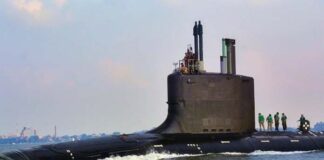Massive investment in new weaponry aimed at containing China, a commitment to more war, and more intervention in the South Pacific—that’s the Turnbull government’s vision for a “capable, agile and potent” defence force in the 2016 Defence White Paper.
The figures are astonishing. The government will hand an extra $29.9 billion to defence between now and 2025-2026. That will make the defence budget $42.4 billion a year in 2021-21—or 2 per cent of GDP.
Turnbull’s priorities are clear. It’s as much money as we need to completely transition Australia to renewable energy, going by the estimates of Beyond Zero Emissions.
The new spending comes as the Coalition’s $57 billion in funding cuts to health (over eight years) are starting to bite. Already, 70 per cent of patients in Emergency departments are waiting more than eight hours to get medical attention.
But it’s Defence, apparently, that’s had “significant under investment”. So where are the billions going?
“Capital expenditure” will double over ten years. There’ll be 1100 new personnel carriers—light enough for airlift to the battlefield but also equipped with grenade launchers.
For just $17 billion, we’ll get 72 of the F-35 joint strike fighters. They’re the world’s most expensive item of military equipment. They carry air-to-air missiles, cruise missiles and guided bombs.
Then there are 12 new submarines. Their potential for “surveillance and protection of our maritime approaches” will secure sea lanes and enforce Australia’s claims at sea.
Plus, there will be a new long-range rocket system for “increased firepower”, and millions for drones.
US alliance
The paper explains that Australia will “seek to broaden and deepen our alliance with the United States”.
Australia already hosts the US spy base Pine Gap, which has been used to target drone strikes across Pakistan and Afghanistan. Under former Labor Prime Minister Julia Gillard, Australia committed to a base for US troops in Darwin.
Reading between the lines, it’s clear Australia is siding firmly with the United States against China.
The US “pivot to Asia”—focusing military resources and seeking alliances in the region in a bid to encircle China—is endorsed through praising the US’s “critical role in underpinning security in our region”.
Half the world’s trade passes through the South China Sea. The route has long been guaranteed by the US Navy, but now China, reliant on the routes for the majority of its trade, is expanding its military presence there.
Despite the economic links between the US, Chinese and Australian economies, Australia will continue to line itself up with the global hegemon to protect its “territory and interests”.
Australia’s long-standing interest in controlling its “backyard” will mean being the “principal security partner for Papua New Guinea, Timor-Leste and Pacific Island Countries in the South Pacific”, meaning Australia will continue to act as a neo-colonial bully, enforcing Australia’s economic interest over small, impoverished nations.
More war
Despite the quagmire that faces Western imperialism in Iraq and Syria, Australia will commit to “practical and effective military contributions to global security operations”.
That means more war and intervention.
The Australian military is currently deployed in 28 countries, and “the overseas presence of Defence personnel will be gradually increased over time”.
That means increasing the size of the military. In fact, the report notes that the Defence workforce will expand to its “largest size since 1993 … offset by ongoing reductions elsewhere in the APS [Australian Public Service] workforce.”
The paper turns bizarre when it comes to discussing terrorism, saying, “Never before has there been a time when external threats so distant from our shores have had the capacity to so quickly affect our direct interests.” Perhaps Defence believes its own propaganda about the terror threat. But they’ll continue to spread it— by increasing their support for US wars in places like the Middle East.
Refugee boats are treated as a security threat. Operation Sovereign Borders will get “more capable offshore patrol vessels, new manned and unmanned aircraft and a new large-hulled multi-purpose patrol vessel, the Australian Defence Vessel Ocean Protector.”
But they’ll do it all with “cultural change”, “gender equality” and more female participation, an effort to restore the damage done to the Defence force’s reputation after repeated scandals over sexual assault and hazing rituals.
Australia is an imperial power in its own right. Its alliance with the US is about having a powerful partner to help it maintain security and stability for Australian capitalism in the region.
And the commitment is bipartisan with Labor: as Anthony Albanese assured us on Insiders, “… defence should be above partisan politics … we’ve supported the thrust of the White Paper.”
By Amy Thomas





